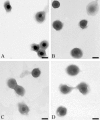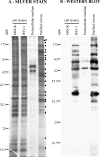Comprehensive characterization of extracellular herpes simplex virus type 1 virions
- PMID: 18596102
- PMCID: PMC2519676
- DOI: 10.1128/JVI.00904-08
Comprehensive characterization of extracellular herpes simplex virus type 1 virions
Abstract
The herpes simplex virus type 1 (HSV-1) genome is contained in a capsid wrapped by a complex tegument layer and an external envelope. The poorly defined tegument plays a critical role throughout the viral life cycle, including delivery of capsids to the nucleus, viral gene expression, capsid egress, and acquisition of the viral envelope. Current data suggest tegumentation is a dynamic and sequential process that starts in the nucleus and continues in the cytoplasm. Over two dozen proteins are assumed to be or are known to ultimately be added to virions as tegument, but its precise composition is currently unknown. Moreover, a comprehensive analysis of all proteins found in HSV-1 virions is still lacking. To better understand the implication of the tegument and host proteins incorporated into the virions, highly purified mature extracellular viruses were analyzed by mass spectrometry. The method proved accurate (95%) and sensitive and hinted at 8 different viral capsid proteins, 13 viral glycoproteins, and 23 potential viral teguments. Interestingly, four novel virion components were identified (U(L)7, U(L)23, U(L)50, and U(L)55), and two teguments were confirmed (ICP0 and ICP4). In contrast, U(L)4, U(L)24, the U(L)31/U(L)34 complex, and the viral U(L)15/U(L)28/U(L)33 terminase were undetected, as was most of the viral replication machinery, with the notable exception of U(L)23. Surprisingly, the viral glycoproteins gJ, gK, gN, and U(L)43 were absent. Analyses of virions produced by two unrelated cell lines suggest their protein compositions are largely cell type independent. Finally, but not least, up to 49 distinct host proteins were identified in the virions.
Figures








Similar articles
-
A pre-immediate-early role for tegument ICP0 in the proteasome-dependent entry of herpes simplex virus.J Virol. 2011 Jun;85(12):5910-8. doi: 10.1128/JVI.00267-11. Epub 2011 Apr 6. J Virol. 2011. PMID: 21471243 Free PMC article.
-
Herpes simplex virus type 1 immediate-early protein ICP27 is required for efficient incorporation of ICP0 and ICP4 into virions.J Virol. 2008 Jan;82(1):268-77. doi: 10.1128/JVI.01588-07. Epub 2007 Oct 24. J Virol. 2008. PMID: 17959681 Free PMC article.
-
Biochemical analysis of infected cell polypeptide (ICP)0, ICP4, UL7 and UL23 incorporated into extracellular herpes simplex virus type 1 virions.J Gen Virol. 2012 Mar;93(Pt 3):624-634. doi: 10.1099/vir.0.039776-0. Epub 2011 Dec 7. J Gen Virol. 2012. PMID: 22158881
-
Involvement of Terminase Complex in Herpes Simplex Virus Mature Virion Egress.Curr Protein Pept Sci. 2022;23(2):105-113. doi: 10.2174/1389203723666220217144432. Curr Protein Pept Sci. 2022. PMID: 35176987 Review.
-
The herpes simplex virus type 1 particle: structure and molecular functions. Review article.APMIS. 1994 May;102(5):321-46. doi: 10.1111/j.1699-0463.1994.tb04882.x. APMIS. 1994. PMID: 8024735 Review.
Cited by
-
Analysis of virion-incorporated host proteins required for herpes simplex virus type 1 infection through a RNA interference screen.PLoS One. 2013;8(1):e53276. doi: 10.1371/journal.pone.0053276. Epub 2013 Jan 3. PLoS One. 2013. PMID: 23301054 Free PMC article.
-
Herpes simplex virus 1 VP22 regulates translocation of multiple viral and cellular proteins and promotes neurovirulence.J Virol. 2012 May;86(9):5264-77. doi: 10.1128/JVI.06913-11. Epub 2012 Feb 22. J Virol. 2012. PMID: 22357273 Free PMC article.
-
Regulation of alphaherpesvirus protein via post-translational phosphorylation.Vet Res. 2022 Nov 17;53(1):93. doi: 10.1186/s13567-022-01115-z. Vet Res. 2022. PMID: 36397147 Free PMC article. Review.
-
Proteomic Comparison of Three Wild-Type Pseudorabies Virus Strains and the Attenuated Bartha Strain Reveals Reduced Incorporation of Several Tegument Proteins in Bartha Virions.J Virol. 2022 Dec 21;96(24):e0115822. doi: 10.1128/jvi.01158-22. Epub 2022 Dec 1. J Virol. 2022. PMID: 36453884 Free PMC article.
-
Extracellular vesicles and their convergence with viral pathways.Adv Virol. 2012;2012:767694. doi: 10.1155/2012/767694. Epub 2012 Jul 25. Adv Virol. 2012. PMID: 22888349 Free PMC article.
References
-
- Adams, R., C. Cunningham, M. D. Davison, C. A. MacLean, and A. J. Davison. 1998. Characterization of the protein encoded by gene UL49A of herpes simplex virus type 1. J. Gen. Virol. 79813-823. - PubMed
-
- America, A. H., and J. H. Cordewener. 2008. Comparative LC-MS: a landscape of peaks and valleys. Proteomics 8731-749. - PubMed
-
- Anderson, L., and C. L. Hunter. 2006. Quantitative mass spectrometric multiple reaction monitoring assays for major plasma proteins. Mol. Cell. Proteomics 5573-588. - PubMed
-
- Baines, J., and C. Duffy. 2006. Nucleocapsid assembly and envelopment of herpes simplex virus, p. 175-204. In R. M. Sandri-Goldin (ed.), Alpha herpesviruses: molecular and cellular biology. Caister Academic Press, Norfolk, United Kingdom.
MeSH terms
Substances
LinkOut - more resources
Full Text Sources

